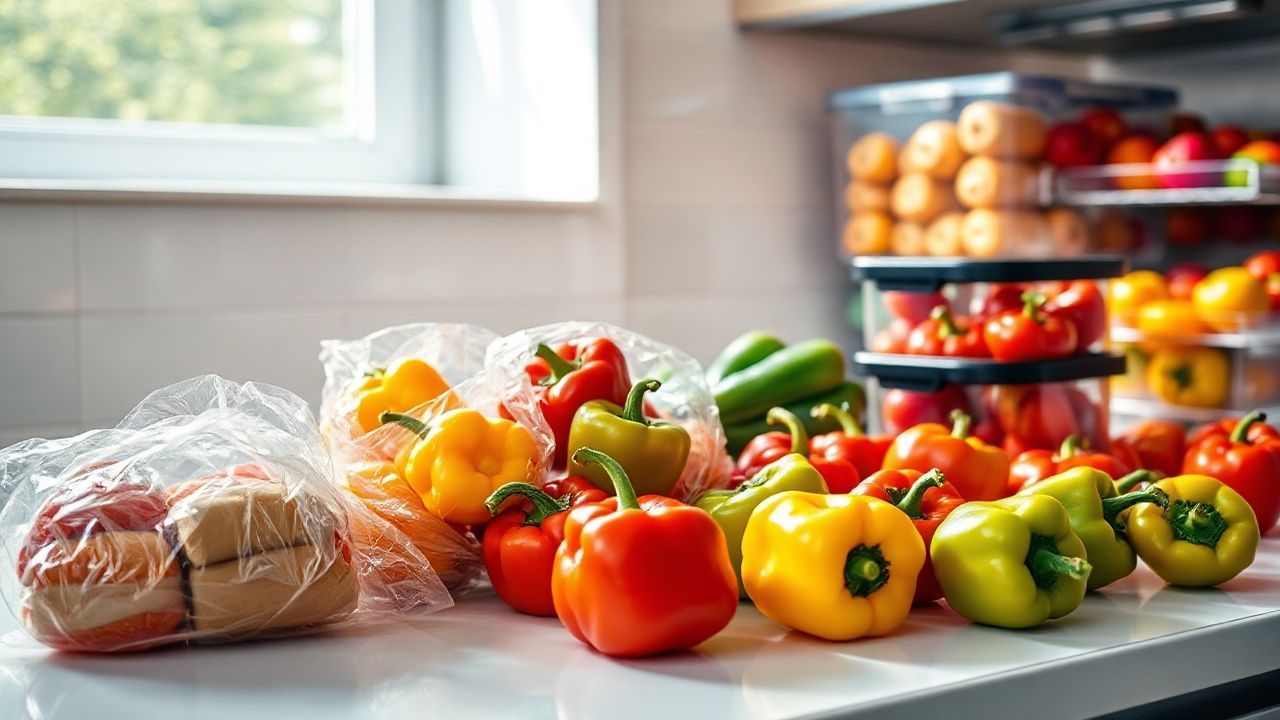Introduction to storing bell peppers
Firstly, it’s essential to select fresh, unblemished bell peppers. Look for firm, brightly colored peppers with smooth, shiny skin. Avoid peppers with bruises, cuts, or soft spots. Once home, store the peppers in a cool, dark, and dry place with proper ventilation. A refrigerator is an ideal choice, as it provides a controlled environment that slows down the ripening process. Place the peppers in a crisper drawer or vegetable compartment, where they can stay fresh for up to two weeks. Keep them away from sources of moisture, such as fruits and vegetables that release ethylene gas, which can accelerate ripening.
For longer-term storage, consider freezing the bell peppers. They can be frozen whole or sliced. To freeze whole peppers, wash them thoroughly and remove the stems and seeds. Place the peppers on a baking sheet and freeze them for about 2 hours or until they are solid. Then, transfer them to freezer-safe bags or containers. Sliced peppers can also be frozen by following a similar process. Simply wash, remove the stems and seeds, and slice the peppers into desired sizes. Spread the slices on a baking sheet and freeze them until solid. Transfer them to freezer-safe bags or containers for convenient storage. Frozen bell peppers can last for several months, retaining their flavor and nutritional value for future use.
Choosing fresh bell peppers for storage
Selecting the perfect bell peppers for long-term storage is crucial to preserve their freshness and flavor. Look for peppers with firm, unblemished skin. Avoid any peppers with soft spots, wrinkles, or cuts. The stems should be intact and green, indicating freshness.
Choose bell peppers that are vibrant in color. Deep red, yellow, or orange peppers typically have a sweeter taste and are ideal for storage. Avoid green peppers, as they tend to have a more bitter flavor and shorter shelf life.
Larger bell peppers generally have thicker walls and are more tolerant to storage conditions. Select peppers that are free of bruises or punctures, which can provide entry points for mold and bacteria.
Once you have selected your bell peppers, store them in a cool, well-ventilated area. Wrapping each pepper individually in paper towels can help absorb excess moisture and prevent spoilage. Alternatively, you can store them in a plastic bag with holes to allow air circulation.
Bell peppers can be stored for several weeks in the refrigerator. For longer-term storage, consider freezing them. Cut the peppers into strips or pieces, remove the seeds, and blanch them briefly in boiling water. After cooling them, pack them into freezer-safe bags or containers. Frozen bell peppers can be stored for up to six months.
Short-term storage tips
1. Selection and Preparation: Choose firm, unblemished bell peppers with vibrant colors and intact stems. Remove any damaged or bruised areas. Trim the stems to reduce moisture loss.
2. Temperature and Humidity: Store bell peppers at refrigerator temperatures between 40°F (4°C) and 45°F (7°C) to slow down ripening and decay. Maintain a relative humidity of around 90-95% to prevent moisture loss and shriveling.
3. Placement: Avoid storing bell peppers near ethylene-producing fruits or vegetables, such as bananas, apples, or tomatoes, as these gases accelerate ripening. Instead, keep them in a dedicated drawer in your refrigerator or a crisper specifically designed for produce.
4. Ethylene Absorption: Place a ripe banana inside a paper bag with your bell peppers to absorb excess ethylene and prolong their freshness. The banana naturally releases an ethylene-absorbing enzyme that can help decelerate the ripening process.
5. Moisture Management: Condensation inside the storage environment can promote mold growth. To avoid this, place bell peppers on paper towels or perforated plastic wrap to absorb excess moisture.
6. Inspection: Regularly monitor your bell peppers for any signs of spoilage, such as soft spots, bruising, or mold. If any issues arise, discard the affected peppers promptly to prevent contamination.
Long-term preservation methods (freezing, pickling)
Pickling is another method that extends the shelf life of bell peppers while adding flavor and tang. To pickle bell peppers, slice them and pack them tightly into jars. Create a brine by combining vinegar, sugar, salt, and spices. Pour the hot brine over the peppers, leaving about 1/2 inch of headspace at the top of the jar. Seal the jars and process them in a boiling water bath for 10-15 minutes. Pickled bell peppers can be stored in a cool, dark place for up to a year.
Both freezing and pickling effectively preserve bell peppers while maintaining their nutritional value. Whether you choose to freeze or pickle your bell peppers depends on your desired storage time and culinary preferences.
Conclusion: Keep your bell peppers fresh
To maintain the optimal freshness and flavor of your bell peppers, proper storage techniques are crucial. By following these simple guidelines, you can extend their shelf life and enjoy their crisp and vibrant goodness for an extended period:
Store bell peppers at the correct temperature and humidity levels. Ideal conditions involve refrigeration at around 40-45°F (4-7°C) and high humidity to prevent moisture loss. A crisper drawer in your refrigerator is typically the best option.
Avoid placing bell peppers near ethylene-producing fruits and vegetables, such as apples, bananas, or pears. These fruits release ethylene gas, which can accelerate the ripening process and shorten the shelf life of bell peppers.
Keep bell peppers whole and uncut until you’re ready to use them. Cutting will expose the flesh to air and moisture, leading to faster spoilage.
If you need to store cut bell peppers, wrap them tightly in plastic wrap or airtight containers to minimize exposure to air and moisture. They will remain fresh for a few days under these conditions.
By implementing these storage techniques, you can preserve the vibrant colors, crisp texture, and sweet flavor of your bell peppers for longer, ensuring they remain a culinary delight for all your meals and preparations.

Leave a Reply